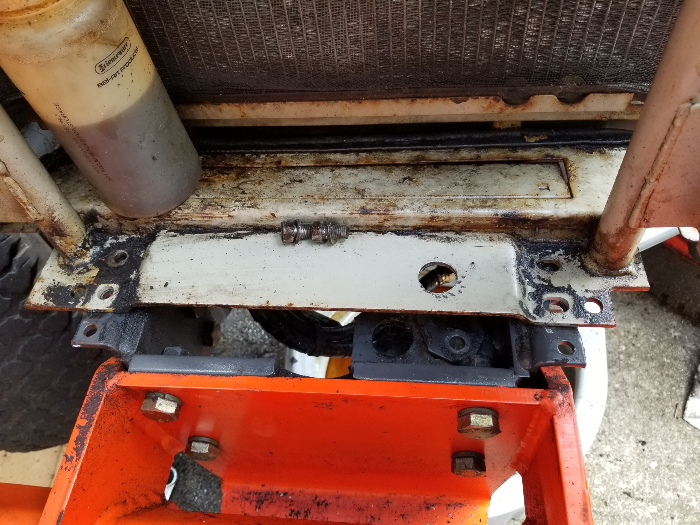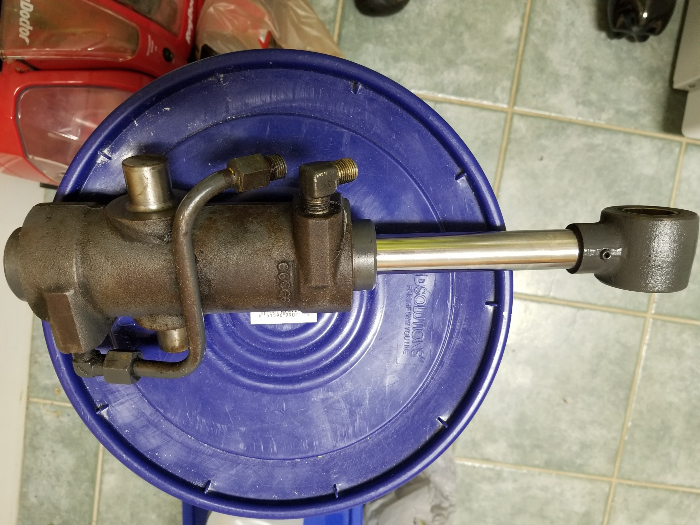Manual Labor
June 14th, 2022Has Kubota Actually Seen This Tractor?
I guess you can’t say you’re a real farmer until you’ve fixed your own hydraulics.
I have done some hydraulic work in the past. It consisted of replacing a rear hydraulic cylinder (“rockshaft cylinder”) on a garden tractor. John Deere welds its small cylinders shut, thoughtfully, so customers won’t be bothered with bad old rebuilding jobs. Instead, you can just buy a very overpriced new cylinder every 5 years and go through the torture of installing it but not the extremely easy and cheap task of rebuilding it.
This is the main reason why I would never buy a John Deere product other than a T-shirt, although there are other reasons which are also pretty good.
I also fixed a leaking fitting on my Kubota’s loader once. That was nice, because fluid used to drip from it constantly, and I got tired of refilling it.
Other than that, I was pretty fortunate until recently, when fluid started shooting out of the Kubota’s steering cylinder so fast, it was not practical to consider refilling it between sessions.
“No problem,” I thought, “Kubota isn’t John Deere. They will not make this unbearable for me.”
Of course, I was wrong about that.
I have a download of a Kubota workshop manual, and its terse, optimistic manuals are a lot like promotional videos tractor companies put out. I wrote about these the other day. They make removing loaders look about as hard as making a gin and tonic. In reality, you may need things like a sledgehammer, a collection of spud wrenches, and a second tractor with a front end loader, and your clothes will be filthy 5 minutes into the job, but they don’t go into that.
Anyway, the manual said I had to remove the radiator, and that meant removing the front end loader, which is nearly impossible on this model. I kept asking people for advice, and someone told me I could get access to the necessary parts without doing all that. This encouraged me to continue trying.
The steering cylinder’s rod has a bit of heavy tubing on the end, and that bit of tubing attaches it to the tractor’s frame. There are a couple of holes in the frame, and a big pin goes through them. The rod end goes between the holes, and the pin passes through it, too. This holds the rod in place.
The pin has a groove around the top, and there is a little piece of heavy plate that fits into that groove. The edge of the plate sits in it and prevents the pin from moving up and down. This keeps your rod in the frame, where it should be. The plate is held down by…well, we’ll get to that.
Kubota said I had to take the radiator out to get to the single (single) bolt holding the plate in. An Internet guy said I just had to turn the steering wheel, and the bolt would reveal itself.
The truth turned out to be unlike anything either of them said. I learned I could access the single bolt by taking out the battery and the platform it sat on. I didn’t need to fool with the radiator. Then I found out there were TWO bolts, not one, and the second one was covered by the plate the battery platform had been attached to.
So the manual said there was one bolt, there were really two, and the second one could only be gripped, badly, by a box wrench. And Kubota put it in way tighter than it had to be, so a box wrench would have rounded it before loosening it.
Amazing.
Did Kubota deliberately make things harder than necessary so they could make more money on labor for repairs? I don’t know. Kubota itself doesn’t do repairs; the dealers do. I would guess Kubota gets the same income, from parts alone, regardless of how long repairs take. And by making warranty repairs harder, Kubota would be sticking it to itself. Which, now that I think about it, is a very Japanese thing to do.
My solution? Making a big ol’ hole. I drilled a 7/8″ part in the plate covering the second bolt, so I could get a socket on it and use a breaker bar.
Making the hole was a joy. No, really. I’m serious.
I did everything right, or at least I tried. I measured to find the location, and I made a dimple with a punch. I used a small drill to make a pilot hole. I used a hole saw to open it up. I used oil and drilled at the proper speed. The pilot drill on the hole saw snapped, and the hole saw bit into the plate, losing several teeth. Okay.
From there, I went to a step bit. I opened the hole up to around 5/8″, but the steps on the bit were too shallow to make a clean, uniform hole, so I had to use two Silver & Deming bits in succession. Finally, I had the hole I wanted, plus several gouges from the hole saw accident.
Fortunately, the gouges will be invisible when the tractor is assembled.
I was able to get a socket on both bolts, and I removed the rod end pin. After that, I managed to detach both hydraulic hoses without breaking anything, and I got the Pitman arm cap off. Then I retracted the rod manually and wiggled the cylinder out. Joy.
One of the great things about hydraulic leaks on farms is that the oil they release traps black dirt, so when you try to fix your problems, you are inundated with filth and oil. I had cleaned the tractor’s relevant parts as well as I could with a pressure washer, but there was still a lot of crud in places I could not hit. It took me quite a while to get the cylinder clean enough to handle.
Now I have a somewhat less dirty cylinder, and I need to visit a hydraulics shop.
Kubota wants $165 for the parts to fix the cylinder. They should cost something like $35. They are very ordinary parts. Kubota doesn’t make its own seals, wipers, and O-rings. I am pretty sure I can pay a shop for labor and still come out way ahead. This is literally a 10-minute job.
There are people out there discouraging amateurs from fixing hydraulic cylinders, threatening all sorts of disastrous consequences. I have looked into it, and it’s all nonsense, probably intended to con people into paying too much. Replacing the parts is an extremely easy job you can do without special tools. It helps if you have a weird tool that compresses inner seals so you can get them inside pistons, but those tools cost $30 a set on Amazon, and a set will cover a wide range of cylinders.
I would fix my cylinder myself if I knew what to order, but the shrewd businessmen at Kubota do not reveal the sizes of their rebuild parts. I may open it up anyway to make sure the interior isn’t scarred up, and perhaps I’ll be able to figure out what I need.
As of this minute, the odds are about 90% that I’ll pay to get the job done.
What are the take-aways here?
1. Kubota writes really bad repair manuals.
2. John Deere is worse because they weld hydraulic cylinders closed.
3. Rebuilding hydraulic cylinders is really easy and relatively cheap.
I am deriving a little satisfaction from doing all this myself instead of paying a dealer $1500 for transportation and repairs and waiting a month to get the tractor back. I would be more satisfied, however, if my tractor hadn’t leaked in the first place. It only has 1200 hours on it.

